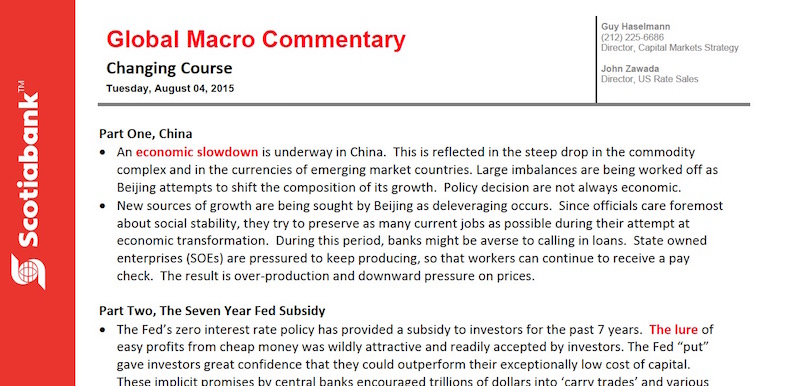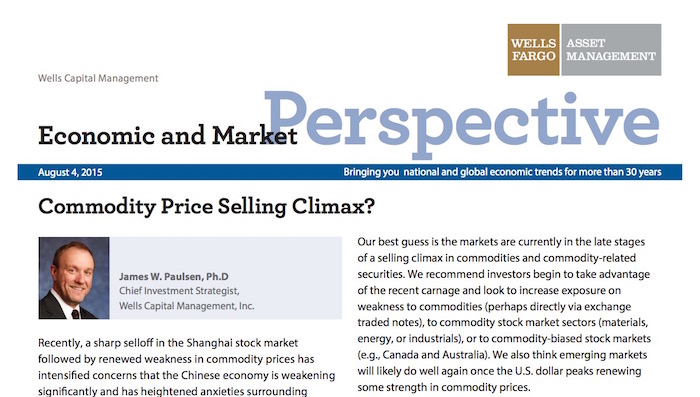Part One, China
• An economic slowdown is underway in China. This is reflected in the steep drop in the commodity complex and in the currencies of emerging market countries. Large imbalances are being worked off as Beijing attempts to shift the composition of its growth. Policy decision are not always economic.
• New sources of growth are being sought by Beijing as deleveraging occurs. Since officials care foremost about social stability, they try to preserve as many current jobs as possible during their attempt at economic transformation. During this period, banks might be averse to calling in loans. State owned enterprises (SOEs) are pressured to keep producing, so that workers can continue to receive a pay check. The result is over-production and downward pressure on prices.
Part Two, The Seven Year Fed Subsidy
• The Fed’s zero interest rate policy has provided a subsidy to investors for the past 7 years. The lure of easy profits from cheap money was wildly attractive and readily accepted by investors. The Fed “put” gave investors great confidence that they could outperform their exceptionally low cost of capital. These implicit promises by central banks encouraged trillions of dollars into ‘carry trades’ and various forms of market speculation.
• Complacent investors maintain these trades, despite the Fed’s warning of a looming reduction in the subsidy, and despite a balance sheet expected to shrink in 2016. It has been a risk-chasing ‘game of chicken’ that is coming to an end. Changing conditions have skewed risk/reward to the downside. This is particularly true because financial assets prices are exceptionally expensive.
• Maybe investors do not believe ‘lift-off’ looms, because the Fed has changed its guidance so many times. Or maybe, investors are interpreting plummeting commodity prices and the steep fall in global trade as warning signs that global growth and inflation are under pressure. Is this why the US 30 year has rallied 40 basis points in the past 3 weeks? (see my July 17th note, “Bonds are Back”)
• Either scenario creates a paradox for risk-seeking investors. If the US economy continues on its current slow progress pace, then the Fed will act on its warning and hike rates in September. However, if the Fed does not hike in September it is likely because problems from China, commodities, Greece, or emerging markets (etc) cause the global outlook to deteriorate further. Neither scenario should be good for risk assets.
Part Three, “Carry Trade”
• During the 2008 crisis, Special Investment Vehicles (SIVs) were primarily responsible for freezing the interbank lending market. SIVs were separate entities set up primarily to earn the ‘carry’ differential between short-dated loans and longer-dated assets purchased with the proceeds of the loans. This legal structure allowed banks to own billions of dollars of securities (CDOs and such) off of their balance sheets. Since the entities were wholly-owned with liquidity guarantees, the vehicles received the same attractive funding rates as the parent banks.
• When the housing crisis (and Lehman collapse) spurred loan delinquencies, banks had to place all of these hidden securities onto their balance sheets. Since the magnitude of the SIV levered assets was unknown to others, bank solvency was questioned, and interbank lending froze. Many of these securities had to be sold at fire sale prices, i.e., prices well below their economic value.
• When the Fed begins to normalize rates, trillions in carry trades will likely begin to unwind. The similarity to 2008 is glaring, except that banks no longer own SIVs. Regulations have chased the ‘carry trades’ from the banking system into the shadow banking system where officials can’t see or measure the risk. The banking system today is, no doubt, far less exposed, but too many sellers could overwhelm the depth of the market, leading to asset price contagion that filters into the real economy.
• The FOMC is probably fearful of such an outcome, and its unknown impact on the broader economy, which could explain why it has delayed ‘lift-off’. It may also be the reason why the Fed emphasizes that the pace of rate normalization will be “gradual”, and will remain “overly-accommodative”. Unfortunately, the Fed recognizes that speculators do not wait to retreat in an orderly manner. They are also fully aware that regulations have impaired market liquidity; figuratively shrinking the exit doors. This is where ‘macro-prudential’ comes in.
Part Four, Counter-Productive Policies Back the Fed into a Corner
• Few lessons have been learned by market ‘booms’, and the ‘busts’ that always follow. ‘Booms’ occur when the Fed diverges the price of money too far below the ‘natural rate of interest’. Easy money flows into ever less-productive assets. As prices are pushed ever-higher, the yield drop cascades down the capital curve. The process cannot be sustained. High prices directly infer lower future returns. Late-stage investors receive the lowest return with the highest level of risk (game of chicken).
• These cycles are tragic because ‘busts’ have negative consequences that are worse than the ‘booms’ are beneficial. During the ‘bust’, elevated asset prices go back down to their original or fundamental value. They may even overshoot on the downside due to the regulatory limitations that have been put in place during the ‘boom’ years.
• The ‘wealth effect’ is, at a minimum, reversed during the ‘bust’. There is no ‘free lunch’. More importantly, after the ‘bust’, the newly acquired higher levels of debt remain. The result is a lower natural economic growth rate, lower levels of future investment, and more regulation, which all lead to decreased profits.
• Zero interest rates undermine market incentive structures. Share buybacks have surpassed capital expenditures. Cheap money makes acquisitions attractive relative to new investment projects. Why not, cheap money implies high uncertainty. Furthermore, excess liquidity encourages malinvestment and over-capacity, and acts as a headwind for both of the Fed’s dual mandates.
• Experimental monetary policy over the past seven years should reveal that attempts at artificial monetary inflation are ineffective. Yet, they give no hints of discarding this failed ideology. Unless this ideology changes, ever-greater quantities of printing just to repair the inevitable bust will be required as the chosen response. No wonder why Bitcoin is intriguing and confidence in fiat currencies has come into question.
• “Two roads converged in the woods and I took the one less traveled by and that has made all the difference.” – Robert Frost
Tomorrow, I will suggest a few recommendations for adjusting Portfolios
Regards,
Guy
Guy Haselmann | Capital Markets Strategy
▬▬▬▬▬▬▬▬▬▬▬▬▬▬▬▬▬▬▬▬▬▬▬▬▬▬▬
Scotiabank | Global Banking and Markets
250 Vesey Street | New York, NY 10281
T-212.225.6686 | C-917-325-5816
guy.haselmann[at]scotiabank.com
Scotiabank is a business name used by The Bank of Nova Scotia















